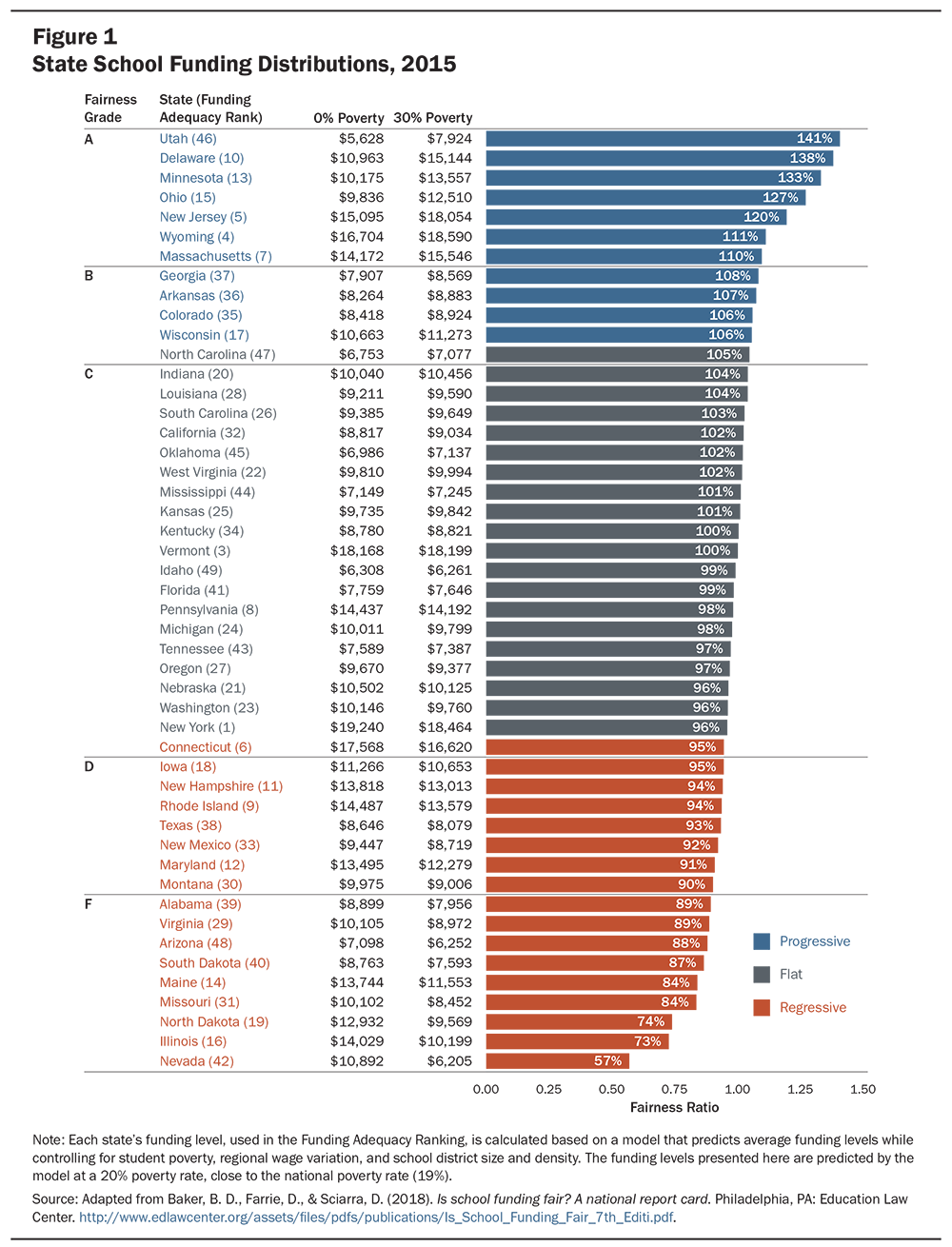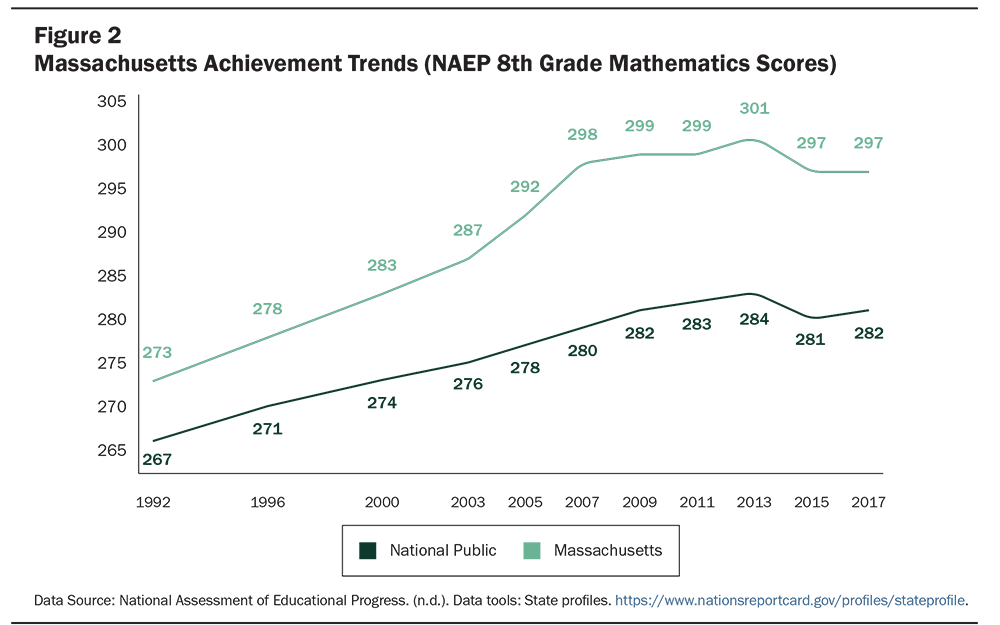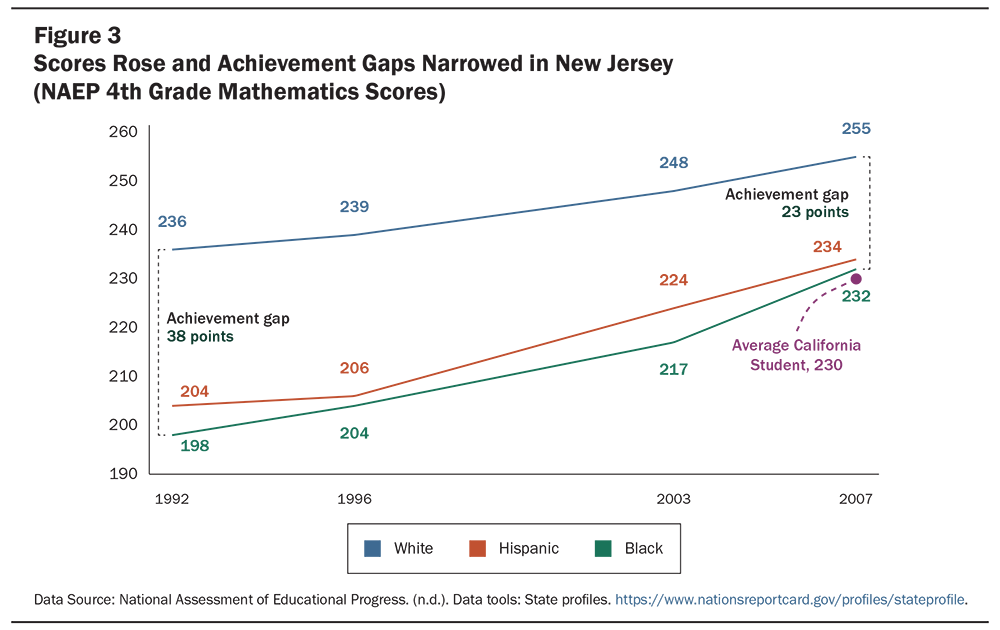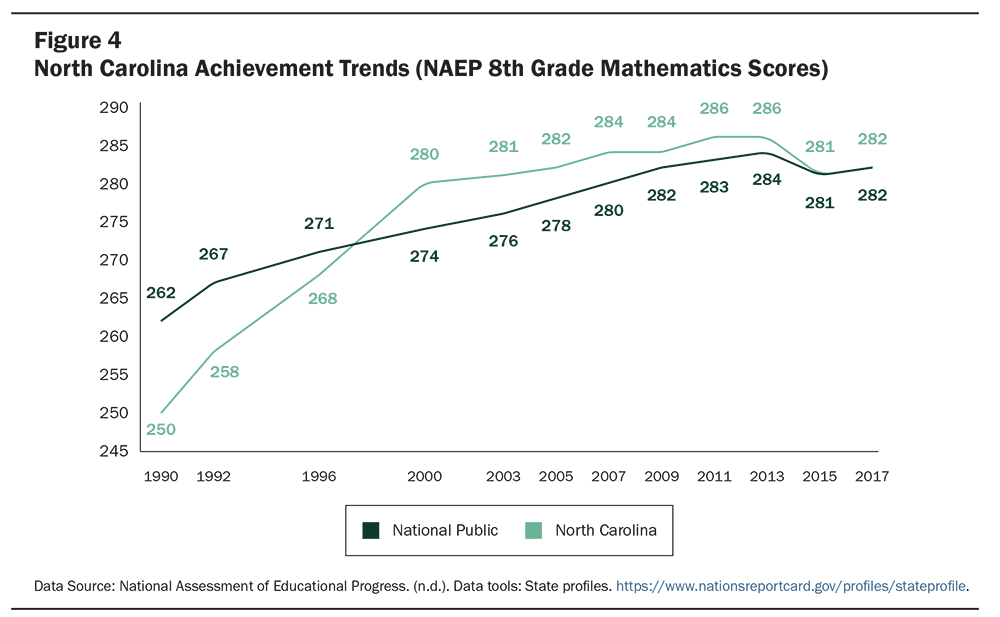Investing for Student Success: Lessons from State School Finance Reforms

Summary
Recent research demonstrates that, when more money is spent on education for students from low-income families, achievement and graduation rates improve. So, too, do life outcomes such as employment, wages, and reduced poverty rates. Investments in instruction, especially high-quality teachers, appear to leverage the largest marginal gains in performance.
School funding reforms in several states have created the conditions for stronger educational outcomes. These reforms funded schools more equitably and provided access to well-prepared and well-supported teachers; standards, curriculum, and assessments focused on 21st-century learning goals; schools organized productively for student and teacher learning; and supportive early learning environments. The report on which this brief is based examines these efforts in four states: Connecticut, Massachusetts, New Jersey, and North Carolina. Their experiences demonstrate that, in the U.S., equity-focused changes can yield results for students but also require steady work.
This report can be found online here.
The Extent of Inequality
Public schools in the United States are among the most inequitably funded of any in the industrialized world. State funding rarely equalizes these disparities adequately. As a result, students in low-wealth districts, who are frequently students from low-income families, typically have the fewest resources, including less-qualified teachers, poorer curriculum, larger classes, and fewer materials for learning. The high child poverty rate in the United States compared to most industrialized nations means that more children live with food and housing insecurity, lack health care, and experience other adverse conditions. These challenges require schools to provide more services, which in turn requires greater school funding.
However, as of 2015, the most recent year for which data are available, only 12 states had progressive funding distributions that provide at least 5% more funding to districts in which student poverty is high (30% or more) as compared to districts in which there is little or no poverty. (See Figure 1.) And of these, only five states also funded education at a strong level of adequacy—Delaware, Massachusetts, Minnesota, New Jersey, and Wyoming.

Meanwhile, at least 17 states had regressive funding distributions that provide less funding to districts with high rates of student poverty. The wealthiest states spend about 3 times what the poorer states spend,Baker, B., Farrie, D., Johnson, M., Luhm, T., & Sciarra, D. G. (2018). Is school funding fair? A national report card (7th edition). Newark, NJ: Education Law Center. (accessed 12/29/18). and in many states, the wealthiest districts spend 2 to 3 times what the poorest districts can spend per pupil.Adamson, F., & Darling-Hammond, L. (2012). Funding disparities and the inequitable distribution of teachers: Evaluating sources and solutions. Education Policy Analysis Archives, 20(37). The Great Recession of 2008 further exacerbated inequities between rich and poor schools when states cut education funding, along with funding in other social welfare areas such as health care and human services. As of 2016 (the most recent nationwide data available), 24 states had not yet returned to pre-2008 levels in their state and local education funding.Leachman, M. (2018). New census data show persistent state school funding cuts. Washington, DC: Center on Budget and Policy Priorities.
Yet, equitable and empowering educational opportunities are increasingly important to the survival and success of both individuals and societies, given the demands of the rapidly changing knowledge-based economy, which demands increasing levels of knowledge and skill from more and more citizens.
The report upon which this brief is based examines a compelling question: How should we invest resources to achieve high-quality education in ways that redress the effects of historical inequities and historical discrimination? It reviews resource inequalities in U.S. schools and analyzes the results of efforts to address these inequalities, nationally and in four states: Connecticut, Massachusetts, New Jersey, and North Carolina. The research shows that learning opportunities were substantially improved in these states by the strategies they undertook. The report concludes with recommendations for federal and state actions that could support greater resource equity.
How Money Matters
For many years, research on the relationship between spending and student learning appeared inconclusive. Due to the limitations of data sets and statistical methods, it was difficult to disentangle the effect of resource allocation from other factors, such as family income, parental education, or school structure. And because children from low-income families have typically attended poorly funded schools, it has been difficult to sort out whether it was their family income or school resources that predicted outcomes.
With recent advances in data sets and statistical methods, researchers have shown that when more money is spent on education, especially for students from low-income families, achievement and graduation rates improve, as do life outcomes. A national study tracking students who started school from about 1960 to 1990 found that children from low-income families in reform states who had 20% more spent on them over the 12 years of school experienced graduation rates 23 percentage points higher than similar children without this benefit. In addition, their household income as adults increased by 52%, and the gap in adult poverty rates between them and their more affluent peers was eliminated.Jackson, C. K., Johnson, R. C., & Persico, C. (2016). The effects of school spending on educational economic outcomes: Evidence from school finance reforms. Quarterly Journal of Economics, 131(1), 157–218.
A study of more recent policies found that, 7 years after school finance changes, the highest-poverty districts in the reform states experienced an average 12% increase in per-pupil spending and a 7 to 12 percentage point increase in graduation rates.Candelaria, C. A., & Shores, K. A. (2017). Court-ordered finance reforms in the adequacy era: Heterogeneous causal effects and sensitivity. Education Finance and Policy, 6, 1–91. Another study of post-1990 reforms found significantly larger gains in achievement than in non-reform states, and, over time, family income became a less powerful predictor of students’ performance in those states.Lafortune, J., Rothstein, J., & Whitmore Schanzenbach, D. (2016). School finance reform and the distribution of student achievement. (IRLE working paper #100-16). Berkeley, CA: Institute for Research on Labor and Employment.
Investments in instruction, especially high-quality teachers, appear to leverage the largest marginal gains in performance.Ferguson, R. F. (1991). Paying for public education: New evidence on how and why money matters. Harvard Journal on Legislation, 28(2), 465–498; Ferguson, R. F., & Ladd, H. F. (1996). “How and Why Money Matters: An Analysis of Alabama Schools” in Ladd, H. F. (Ed.). Holding Schools Accountable (pp. 265–298). Washington, DC: Brookings Institution; Betts; J. R., Rueben, K. S., & Danenberg, A. (2000). Equal resources, equal outcomes? The distribution of school resources and student achievement in California. San Francisco, CA: Public Policy Institute of California. The places that have made investments in instruction share a number of features: supportive early learning environments; equitably funded schools; well-prepared and well-supported teachers; standards, curriculum, and assessments focused on 21st-century learning goals; and schools organized productively for student and teacher learning.
The full report reviews strategies in four states that have undertaken reforms that have created those conditions and produced stronger educational outcomes—Connecticut, Massachusetts, New Jersey, and North Carolina—described in brief here.
Connecticut and Massachusetts undertook reforms that produced advances in equity, adequacy, and achievement during the early 1990s. New Jersey made great strides a decade later. As a “majority-minority” state, New Jersey’s position as one of the top-achieving states in the country is particularly noteworthy. These three states are routinely among the four highest scoring on the U.S. National Assessment of Educational Progress (NAEP) in reading and mathematics, and they perform at levels comparable to the highest-achieving nations in the world on the Program for International Student Assessment (PISA). North Carolina’s sustained investments over two eras of reform in the 1980s and the 1990s enabled it to become the first high-poverty Southern state to achieve above national norms and to make more progress in closing the achievement gap during the 1990s than any other state.
Connecticut
Beginning in the late 1980s, following the Horton v. Meskill (1977) and Sheff v. O’Neill (1 989) decisions, Connecticut launched ambitious efforts to equalize educational opportunity while improving teaching. The state’s 1986 Education Enhancement Act was a linchpin of these reforms.Baron, J. B. (1999). Exploring high and improving reading achievement in Connecticut. Washington, DC: National Educational Goals Panel. It coupled major increases in teacher salaries with higher standards for teacher education and licensing. Funds were allocated based on district need and the number of fully certified teachers, creating incentives for districts to recruit those who met the new certification standards and for individuals to meet those standards. With these incentives, plus service scholarships to underwrite preparation for high-need candidates, the state eliminated emergency credentials and attracted high-ability teacher candidates.
Connecticut also invested deeply in training for principals and ongoing professional development for teachers, while it enacted new standards and performance-based assessments for students, focused on higher-order thinking skills. Following steep gains throughout the decade, by 1998 Connecticut 4th-graders ranked first in the nation in reading and mathematics on the NAEP, despite increasing numbers of low-income, minority, and new immigrant students in its public schools during that time. The achievement gap between White students and students of color decreased, and the more than 25% of Connecticut’s students who were Black or Hispanic substantially outperformed their counterparts nationally. Connecticut also became the top-performing state in writing, and, in the world, only top-ranked Singapore outscored its students in science.
Unfortunately, Connecticut’s equity progress began to slip when the legislature stopped funding the equalization components of the initiative, and disparities re-emerged during the early 2000s, during a state economic recession. The state began to invest once again between 2005 and 2008 before the national recession hit. More legal action followed in the 2010s,Connecticut Coalition for Justice in Education Funding, Inc. v. Rell, No. X07-HHD-CV-145037565-S, 2016 WL 4922730, at *6 (Conn. Super. Ct. Sep. 7, 2016). and state policymakers are working to improve spending equity across the state. It remains to be seen how new efforts at equalization will rebalance the allocation of resources in the state.
Massachusetts
Massachusetts’s reforms began a few years after Connecticut’s, and the state ultimately surpassed Connecticut as the highest achieving in the nation. The story of this meteoric rise began with the Hancock v. Driscoll (1992) decision that required an overhaul of the state’s school funding. The school finance formula adopted in 1993 as part of Massachusetts’s Education Reform Act stimulated substantially greater investments in needier schools by allocating additional weights for students from low-income families and those who are English learners. Furthermore, state funding in local early childhood programs increased by 500% in the first 4 years of the reform and by more in subsequent years.
The state also undertook a comprehensive reform featuring new student standards and assessments demanding more intellectually ambitious teaching and learning. The initiatives included stronger licensing requirements for teachers, and expanded access to high-quality professional learning opportunities for teachers and school leaders. The Attracting Excellence to Teaching Program subsidized preparation for qualified entrants into teaching for high-need fields and locations.
By 2002, the state had dramatically improved overall achievement and sharply reduced its achievement gap and has since led the states in student achievement on the NAEP. (See Figure 2.) In reading and science, Massachusetts performs comparably with the highest-achieving countries in the world, even as the United States has fallen in the international achievement rankings.
Like Connecticut, Massachusetts has experienced some retrenchment as a function of tax caps that especially disadvantage low-wealth communities. It has not fully funded its weighted student funding formula, and it has recalculated poverty rates in ways that undercount children from low-income families, especially those who are undocumented. Renewed legal action is underway, with the Brockton school board—which had launched the original class action lawsuit that led to the historic 1993 Education Reform Act—setting aside $100,000 in 2017 to launch a new lawsuit against the state.

New Jersey
New Jersey’s hard-won path to adequacy came after nine court rulings seeking equalization in school funding for urban districts serving predominantly children from low-income families. After 3 decades of litigation, the state made a major investment in what it called “parity” for low-wealth, high-minority districts beginning in 1996–97, an investment in preschool initiated in 2000, and an intensive instructional improvement initiative in 2003.
Funds were allocated to implement a new state curriculum linked to the state standards; support whole school reform; provide early childhood education for 3- and 4-year-olds along with full-day kindergarten; enable class-size reductions; invest in technology; ensure adequate facilities; and support health, social services, alternative, and summer school programs to help students catch up. In the highest-need districts, studies showed that the added resources were directed largely to instructional personnel, and this increase in spending noticeably improved the achievement of students of color on statewide tests.
By 2007, New Jersey had sharply increased its standing on reading and mathematics assessments nationally and was one of four states that made the most progress in closing achievement gaps between White and Black and Latino/a students over the previous 4 years in both 4th and 8th grade reading and mathematics. (See Figure 3.)
However, as in Connecticut and Massachusetts, the battle for equity in New Jersey continues. For several years during the administration of Governor Chris Christie, the state failed to fully fund the School Funding Reform Act of 2008 and held funding flat, leaving districts with growing enrollments—often due to swelling immigration—with no increases and increasingly inadequate resources. These cuts were followed by achievement dips, which reduced but did not yet eliminate the large differential between New Jersey and the rest of the nation. Governor Phil Murphy, elected in 2016, vowed to rekindle the path to equity in the state. It remains to be seen what the next steps to educational investment in New Jersey will be.

North Carolina
The first wave of major investment in North Carolina was launched with the Elementary and Secondary School Reform Act of 1983, which enhanced school funding, upgraded curriculum expectations, and increased standards for entering teaching and school administration. It also authorized a noted scholarship program—the North Carolina Teaching Fellows—to recruit talented individuals into teaching; expanded professional development; and created expectations for staffing, personnel evaluation, class sizes, and instructional time. It also boosted teacher salaries in the mid-1980s and again in the 1990s.
North Carolina also increased licensing requirements for teachers and principals and required national accreditation for all publicly funded schools of education, leading many colleges to improve their curriculum and increase their investments in preparing teachers. Studies now show that teachers trained by North Carolina teachers colleges are more effective and stay in the profession longer than teachers who enter from out of state or through the state’s alternative certification program.Henry, G. T., Purtell, K. M., Bastian, K. C., Fortner, C. K., Thompson, C. L., Campbell, S. L., & Patterson, K. M. (2014). The effects of teacher entry portals on student achievement. Journal of Teacher Education, 65(1), 7–23.
The 1997 Educational Excellence Act allocated funds to further upgrade the quality of teacher preparation and mentoring and raise minimum teacher salaries. Importantly, it created a 12% salary increase for teachers who achieved National Board certification, an accomplishment that has been associated with greater teacher effectiveness.For a summary of research, see: National Research Council. (2008). Assessing Accomplished Teaching: Advanced-Level Certification Programs. Washington, DC: National Academies Press. It also substantially upgraded principal training and support for principals to experience intensive internships as part of their training, another move associated with greater effectiveness.
The state’s Smart Start program, an award-winning early childhood initiative, was launched in 1993. Evaluations have found that the program has contributed significantly to preschool quality and to children’s skills and abilities associated with readiness to succeed in school.Bryant, D., Maxwell, K., Taylor, K., Poe, M., Peisner-Feinberg, E., & Bernier, K. (2003). Smart Start and preschool child care quality in NC: Change over time and relation to children’s readiness. Chapel Hill, NC: FPG Child Development Institute; Wechsler, M., Kirp, D., Tinubu Ali, T., Gardner, M., Maier, A., Melnick, H., & Shields, P. (2016). The road to high-quality early learning: Lessons from the states. Palo Alto, CA: Learning Policy Institute.
During the 1990s, North Carolina posted the largest student achievement gains of any state in mathematics (see Figure 4) and realized substantial progress in reading. It was also the most successful state in the nation in narrowing the achievement gap between White students and students of color.
Educational inequality was not vanquished, however. Deep cuts in spending have occurred since 2008, and many programs launched during the 1990s have been reduced or eliminated. Since then, average student achievement on the NAEP has declined, and achievement gaps between Black and White students have grown. With the state still under court monitoring from the Leandro lawsuit, which declared the state funding system unconstitutional in 2004, Governor Roy Cooper, along with plaintiffs and defendants in the lawsuit, has agreed to a research-based action plan currently being developed to address these inequalities.

Recommendations
Both federal and state governments can make a difference in achieving greater equity and adequacy in school funding. The federal government set a precedent for enforcing educational standards through its expectations in the last two authorizations of the Elementary and Secondary Education Act—the most recent titled the Every Student Succeeds Act (ESSA). The act requires states to develop means for monitoring progress toward student learning goals as a condition of receiving federal funds. It could equally tie federal education funding to each state’s movement toward equitable access to education resources. Furthermore, in addition to investing in children’s basic welfare, the federal government could:
- Equalize allocations of ESSA resources across states so that high-poverty states receive a greater and fairer share. Allocation formulas should use indicators of student need, with adjustments for cost-of-living differentials, rather than relying on current measures of spending that disadvantage poor states.
- Enforce comparability provisions for ensuring equally qualified teachers are assigned to schools serving different populations of students. The law already requires that states develop policies and incentives to balance the qualifications of teachers across schools serving more- and less-advantaged students, but this aspect of the law is weakly enforced, and wide disparities persist.
- Require states to report and act on opportunity indicators to accompany their reports of academic progress for each school, reflecting the availability of well-qualified teachers; strong curriculum opportunities; books, materials, and equipment (such as science labs and computers); and adequate facilities. ESSA includes several expectations for reporting the educational resources students receive,Cook-Harvey, C. M., Darling-Hammond, L., Lam, L., Mercer, C., & Roc, M. (2016). Equity and ESSA: Leveraging educational opportunity through the Every Student Succeeds Act. Palo Alto, CA: Learning Policy Institute. and states have incorporated others into their accountability and improvement systems.Kostyo, S., Cardichon, J., & Darling-Hammond, L. (2018). Making ESSA’s equity promise real: State strategies to close the opportunity gap. Palo Alto, CA: Learning Policy Institute. The law requires a resource audit for schools identified as in need of intervention and support, as well as the collection of measures regarding funding, staffing, and access to advanced courses. To live up to the spirit of the law, the federal government should evaluate progress on these opportunity measures and require states to meet a set of opportunity-to-learn standards for schools identified as failing. As a condition for receiving federal funds, each state should include in its application for federal funds a report describing the state’s demonstrated movement toward adequacy and equitable access to these education resources—and a plan for further progress.
Meanwhile, states need to figure out not only how much money to invest in education, but also how to send that money to districts and schools in ways that will translate into strong educational programs. As the models in this report show, state funding can be allocated in ways that are more effective for improving the central work of schools. States can:
- Focus funding on pupil needs and the costs of meeting the state’s standards so that all districts can attend to the central tasks of education: hiring effective educators and providing the materials needed to teach the standards, plus any additional services their specific mix of students requires. One option is to fund schools based on equal dollars per student adjusted or weighted for specific student needs, such as poverty, limited English proficiency, foster care or homeless status, and special education status, and further adjusted for geographic cost differentials of various kinds.
- Develop a reliable base of funding without a bevy of categorical programs that come and go. The gains made by states that have seen strong outcomes from their school funding reforms have been the result of continuity in funding and the flexibility to make locally appropriate, strategic decisions about how to spend resources to achieve results.
- Ensure high-quality preschool for children who may have fewer learning opportunities or greater learning needs before they enter school—for example, children from low-income families, new English learners, and children with disabilities. This closes much of the gap that would otherwise be present at entry to kindergarten and launches children into their educational careers from a much more even playing field.
- Enable districts to hire and keep well-prepared educators by coupling funding increases that support improved salaries and working conditions in previously under-resourced districts with stronger educator preparation, induction and mentoring for novices, and ongoing professional learning. Once resources are in place to recruit qualified teachers and principals to all communities, it is important to ensure that they have the professional knowledge and skills to teach and lead schools successfully.
In order for districts to hire more qualified staff, the state needs to ensure that a supply of well-prepared staff is available for them to recruit. This requires that the state develop and enforce standards for teacher quality and create a strong, steady supply of effective practitioners through salary and training incentives—including service scholarships that underwrite preparation and professional development that supports success in the job. These investments go beyond what districts themselves can do, even with a more stable and equitable distribution of local resources.
As the fate of individuals and nations is increasingly interdependent, the quest for access to an equitable, empowering education for all people has become a critical issue for the nation as a whole. No society can thrive in a technological, knowledge-based economy by starving large segments of its population of learning. The path to our mutual well-being is built on equal educational opportunity. And such opportunity begins with an equitable, purposeful school funding system that allows all schools to support high-quality teaching for each and every child.
Investing for Student Success: Lessons From State School Finance Reforms (policy brief) by Linda Darling-Hammond is licensed under a Creative Commons Attribution-NonCommercial 4.0 International License.
This research was supported by the Raikes Foundation. Core operating support for the Learning Policy Institute is provided by the Sandler Foundation, the William and Flora Hewlett Foundation, and the Ford Foundation. We are grateful to them for their generous support. The ideas voiced here are those of the authors and are not to be attributed to our funders.
Photo courtesy of Allison Shelley/The Verbatim Agency for American Education: Images of Teachers and Students in Action.
